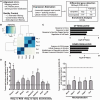Cerebrospinal fluid ceramides from patients with multiple sclerosis impair neuronal bioenergetics
- PMID: 24893707
- PMCID: PMC4164163
- DOI: 10.1093/brain/awu139
Cerebrospinal fluid ceramides from patients with multiple sclerosis impair neuronal bioenergetics
Erratum in
-
Corrigendum.Brain. 2015 Jul;138(Pt 7):e367. doi: 10.1093/brain/awv090. Brain. 2015. PMID: 26106099 Free PMC article. No abstract available.
Abstract
Axonal damage is a prominent cause of disability and yet its pathogenesis is incompletely understood. Using a xenogeneic system, here we define the bioenergetic changes induced in rat neurons by exposure to cerebrospinal fluid samples from patients with multiple sclerosis compared to control subjects. A first discovery cohort of cerebrospinal fluid from 13 patients with multiple sclerosis and 10 control subjects showed that acute exposure to cerebrospinal fluid from patients with multiple sclerosis induced oxidative stress and decreased expression of neuroprotective genes, while increasing expression of genes involved in lipid signalling and in the response to oxidative stress. Protracted exposure of neurons to stress led to neurotoxicity and bioenergetics failure after cerebrospinal fluid exposure and positively correlated with the levels of neurofilament light chain. These findings were validated using a second independent cohort of cerebrospinal fluid samples (eight patients with multiple sclerosis and eight control subjects), collected at a different centre. The toxic effect of cerebrospinal fluid on neurons was not attributable to differences in IgG content, glucose, lactate or glutamate levels or differences in cytokine levels. A lipidomic profiling approach led to the identification of increased levels of ceramide C16:0 and C24:0 in the cerebrospinal fluid from patients with multiple sclerosis. Exposure of cultured neurons to micelles composed of these ceramide species was sufficient to recapitulate the bioenergetic dysfunction and oxidative damage induced by exposure to cerebrospinal fluid from patients with multiple sclerosis. Therefore, our data suggest that C16:0 and C24:0 ceramides are enriched in the cerebrospinal fluid of patients with multiple sclerosis and are sufficient to induce neuronal mitochondrial dysfunction and axonal damage.
Keywords: axonal degeneration; demyelinating disease; lipid metabolism; mitochondria; neurodegenerative mechanism.
© The Author (2014). Published by Oxford University Press on behalf of the Guarantors of Brain. All rights reserved. For Permissions, please email: journals.permissions@oup.com.
Figures






Similar articles
-
A metabolic perspective on CSF-mediated neurodegeneration in multiple sclerosis.Brain. 2019 Sep 1;142(9):2756-2774. doi: 10.1093/brain/awz201. Brain. 2019. PMID: 31305892
-
Cerebrospinal fluid lactate is associated with multiple sclerosis disease progression.J Neuroinflammation. 2016 Feb 10;13:36. doi: 10.1186/s12974-016-0502-1. J Neuroinflammation. 2016. PMID: 26863878 Free PMC article.
-
Bacterial neurotoxic metabolites in multiple sclerosis cerebrospinal fluid and plasma.Brain. 2022 Apr 18;145(2):569-583. doi: 10.1093/brain/awab320. Brain. 2022. PMID: 34894211 Free PMC article.
-
Links between ceramides and cardiac function.Curr Opin Lipidol. 2022 Feb 1;33(1):47-56. doi: 10.1097/MOL.0000000000000802. Curr Opin Lipidol. 2022. PMID: 34889803 Free PMC article. Review.
-
Regulation of ceramide-induced neuronal death: cell metabolism meets neurodegeneration.Brain Res Rev. 2009 Mar;59(2):333-46. doi: 10.1016/j.brainresrev.2008.10.001. Epub 2008 Oct 25. Brain Res Rev. 2009. PMID: 18996148 Review.
Cited by
-
Metabolic Control of Astrocyte Pathogenic Activity via cPLA2-MAVS.Cell. 2019 Dec 12;179(7):1483-1498.e22. doi: 10.1016/j.cell.2019.11.016. Epub 2019 Dec 5. Cell. 2019. PMID: 31813625 Free PMC article.
-
Ceramide/Sphingosine 1-Phosphate Axis as a Key Target for Diagnosis and Treatment in Alzheimer's Disease and Other Neurodegenerative Diseases.Int J Mol Sci. 2022 Jul 22;23(15):8082. doi: 10.3390/ijms23158082. Int J Mol Sci. 2022. PMID: 35897658 Free PMC article. Review.
-
Interferon-Beta Increases Plasma Ceramides of Specific Chain Length in Multiple Sclerosis Patients, Unlike Fingolimod or Natalizumab.Front Pharmacol. 2016 Nov 3;7:412. doi: 10.3389/fphar.2016.00412. eCollection 2016. Front Pharmacol. 2016. PMID: 27857690 Free PMC article.
-
Neuroprotective effect of neuron-specific deletion of the C16 ceramide synthetic enzymes in an animal model of multiple sclerosis.Glia. 2025 Feb;73(2):271-290. doi: 10.1002/glia.24631. Epub 2024 Nov 3. Glia. 2025. PMID: 39489703 Free PMC article.
-
The topograpy of demyelination and neurodegeneration in the multiple sclerosis brain.Brain. 2016 Mar;139(Pt 3):807-15. doi: 10.1093/brain/awv398. Epub 2016 Feb 8. Brain. 2016. PMID: 26912645 Free PMC article.
References
-
- Alcazar A, Regidor I, Masjuan J, Salinas M, Alvarez-Cermeno JC. Axonal damage induced by cerebrospinal fluid from patients with relapsing-remitting multiple sclerosis. J Neuroimmunol. 2000;104:58–67. - PubMed
Publication types
MeSH terms
Substances
Grants and funding
LinkOut - more resources
Full Text Sources
Other Literature Sources
Medical

